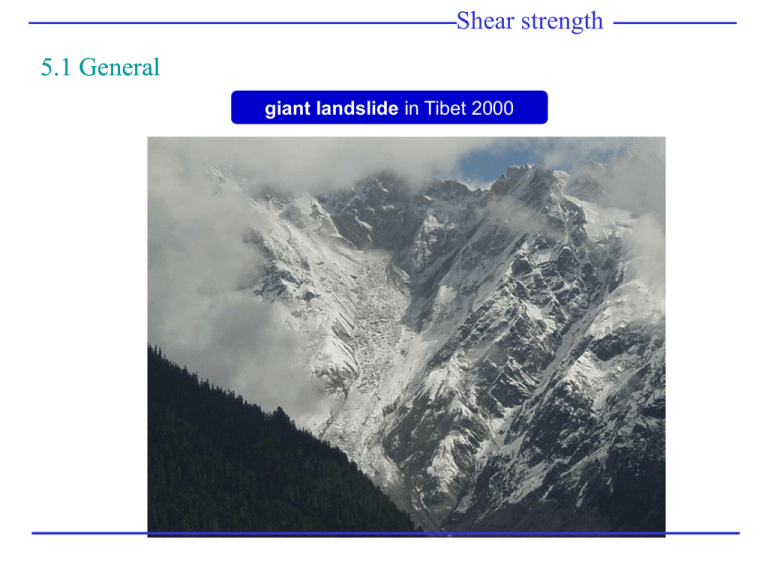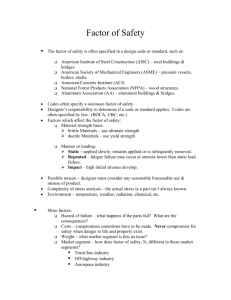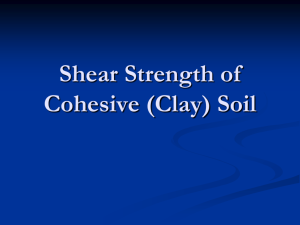Document
advertisement

Shear strength 5.1 General giant landslide in Tibet 2000 Shear strength 5.1 General granary foundation failure on clay Shear strength 5.1 General Foundation soil liquefaction caused by earthquake Shear strength 5.1 General Embankment Retaining wall Foundation Key problem: shear strength Shear strength 5.1 General Collapse Rotational slip Translation slip flow slide Shear strength 5.2 Coulomb law τf = c + σ’ tan φ τf = shear strength c = cohesion φ = angle of internal friction f 粘土 c σ1 major principle stress σ3 σ3 Minor principle stress Confining stress σ1 Shear strength Consider the following situation: A normal stress is applied vertically and held constant A shear stress is then applied until failure 3 3 1 3 1 dlcos dlsin 1 Shear strength • For any given normal stress, there will be one value of shear stress • If the normal stress is increased, the shear stress will typically increase in sands and stay the same in clays O A(, ) 3 2 1/2(1 +3 ) 2 1 1 1 2 1 3 3 2 1 2 2 Shear strength 5.3 Mohr–Coulomb failure criterion A c 3 f 2 f 1 cctg 1/2(1 +3 ) 1 1 3 2 sin 1 c cot 1 3 2 o 2c tan 45 2 2 o 2 o 3 1 tan 45 2c tan 45 2 2 1 3 tan 2 45o 2 For sandy soil: c=0 2 o 3 1 tan 45 2 1 3 tan 2 45o Shear strength A c 3 max f 2 f cctg 1/2(1 +3 ) 1 1 f 90 45 2 2 45 max In the case represented by the figures in this chapter, in which it is assumed that the vertical direction is the direction of the major principal stress, the planes on which the stresses are most critical make an angle π/4 − /2 with the vertical direction. Thus it can be expected that sliding failure will occur in planes that are somewhat steeper than 45. If for instance = 30, which is a normal value for sands, failure will occur by sliding along planes that make an angle of 30 with the vertical direction. Shear strength 5.4 Shear test (1) Direct shear test Normal stress σn Shear stress σ3 Soil Shear strength Direct shear test is Quick and Inexpensive Shortcoming is that it fails the soil on a designated plane which may not be the weakest one Shear strength Shear strength Shear strength • The discussion thus far have referenced failure of the soil. • Failure is indicated by excessive strain with little to no increase (even decrease) in stress. • After failure, the soil strength does not go to 0 • The soil retains residual strength Peak Strength Shear stress Residual Strength Shear displacement Shear strength Shear stress c Overconsolidated OCR >1 normallyconsolidated OCR=1 φ normal stress Typical plot for clays - drained condition Shear strength (2) Triaxial shear test •The test is designed to as closely as possible mimic actual field or “in situ” conditions of the soil. △ 3 3 3 3 3 3 △ Shear strength Shear strength Triaxial tests are run by: saturating the soil applying the confining stress (called σ3) Then applying the vertical stress (sometimes called the deviator stress) until failure 3 main types of triaxial tests: Consolidated – Drained Consolidated – Undrained Unconsolidated Undrained Shear strength The specimen is saturated Confining stress (σ3) is applied This squeezes the sample causing volume decrease Drain lines kept open and must wait for full consolidation (u = 0) to continue wit test Once full consolidation is achieved, normal stress applied to failure with drain lines still open Normal stress applied very slowly allowing full drainage and full consolidation o sample during test (u = 0) f=f =’ Shear strength (3) Unconfined compression test qu qu • The specimen is not placed in the cell • Specimen is open to air with a σ3 of 0 • Test is similar to concrete compression test, except with soil (cohesive – why?) • Applicable in most practical situations – foundations for example. • Drawing Mohrs circle with σ3 at 0 and the failure (normal) stress σ3 defining the 2nd point of the circle – often called qu in this special case • c becomes ½ of the failure stress Shear strength Shear strength Shear strength unconfined compression apparatus 量表 量力环 qu 加压 框架 升降 螺杆 qu 无侧限压缩仪 Shear strength unconfined compression apparatus Shear strength unconfined compression apparatus u=0 qu f cu 2 cu qu Shear strength sensitivity the effects of disturbance of soil constitutive property on soil strength qu St qu ' Low sensitivity 1<St≤2 Middle sensitivity 2< St≤4 High sensitivity St>4 Shear strength (4) Vane shear test This test is used for the in-situ determination of the undrained strength of intact, fully saturated clays; the test is not suitable for other types of soil. In particular, this test is very suitable for soft clays, the shear strength of which may be significantly altered by the sampling process and subsequent handling. Generally, this test is only used in clays having undrained strengths less than 100 kN/m2. This test may not give reliable results if the clay contains sand or silt laminations. f 2 M max D D 2 H 3 Shear strength Example Shear strength Shear strength Shear strength Remark • Triaxial tests rarely run • The unconfined test is very common • In most cases, clays considered φ = 0 and c is used as the strength • Sands are considered c = 0 and φ is the strength parameter • Direct shear test gives us good enough data for sand / clay mixes (soils with both c and φ) • Tables showing N value vs strength very commonly used (page 567 for clays for example).






